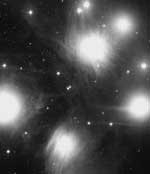
Image credit: NOAO
Astronomers from NASA’s Jet Propulsion Laboratory have measured the distance to the Pleiades star cluster to greatest precision ever. After a decade’s worth of interferometric measurements, the team found that the star cluster is between 434 and 446 light years from Earth. This is important because the European Hipparcos satellite previously measured a distance to the cluster that would have contradicted theoretical models of the life cycles of stars. This new measurement shows that Hipparcos was incorrect, and the established theory still holds.
The cluster of stars known as the Pleiades is one of the most recognizable objects in the night sky, and for millennia has been celebrated in literature and legend. Now, a group of astronomers has obtained a highly accurate distance to one of the stars of the Pleiades known since antiquity as Atlas. The new results will be useful in the longstanding effort to improve the cosmic distance scale, and to conduct research on the stellar life-cycle.
In the January 22 issue of the journal Nature, astronomers from the California Institute of Technology and NASA?s Jet Propulsion Laboratory, both in Pasadena, Calif., report the best-ever distance to the double-star Atlas. The star, along with “wife” Pleione and their daughters, the “seven sisters,” are the principal stars of the Pleiades that are visible to the unaided eye, although there are actually thousands of stars in the cluster. Atlas, according to the team’s decade of careful interferometric measurements, is somewhere between 434 and 446 light-years from Earth.
The range of distance to the Pleiades cluster may seem somewhat imprecise, but in fact is accurate by astronomical standards. The traditional method of measuring distance is by noting the precise position of a star and then measuring its slight change in position when Earth itself has moved to the other side of the sun. This approach can also be used to find distance on Earth: If you carefully record the position of a tree an unknown distance away, move a specific distance to your side, and measure how far the tree has apparently “moved,” then it’s possible to calculate the actual distance to the tree by using trigonometry.
However, this procedure gives only a rough distance estimate to even the nearest stars, due to the gigantic distances involved and the subtle changes in stellar position that must be measured.
The team’s new measurement settles a controversy that arose when the European satellite Hipparcos provided a much shorter distance measurement to the Pleiades than expected and contradicted theoretical models of the life cycles of stars.
This contradiction was due to the physical laws of luminosity and its relationship to distance. A 100-watt light bulb one mile away looks exactly as bright as a 25- watt light bulb half a mile away. So to figure out the wattage of a distant light bulb, we have to know how far away it is. Similarly, to figure out the “wattage” (luminosity) of observed stars, we have to measure how far away they are. Theoretical models of the internal structure and nuclear reactions of stars of known mass also predict their luminosities. So the theory and measurements can be compared.
However, the Hipparcos data provided a distance lower than that assumed from the theoretical models, thereby suggesting either that the Hipparcos distance measurements themselves were off, or else that there was something wrong with the models of the life cycles of stars. The new results show that the Hipparcos data was in error, and that the models of stellar evolution are indeed sound.
The new results come from careful observation of the orbit of Atlas and its companion — a binary relationship that wasn’t conclusively demonstrated until 1974 and certainly was unknown to ancient watchers of the sky. Using data from the Mount Wilson stellar interferometer, next to the historic Mount Wilson Observatory, and the Palomar Testbed Interferometer at Caltech’s Palomar Observatory near San Diego, the team determined a precise orbit of the binary.
Interferometry is an advanced technique that allows, among other things, for the “splitting” of two bodies so far away that they normally appear as a single blur, even in the biggest telescopes. Knowing the orbital period and combining it with orbital mechanics allowed the team to infer the distance between the two bodies, and with this information, to calculate the distance of the binary to Earth.
“For many months I had a hard time believing our distance estimate was 10 percent larger than that published by the Hipparcos team,” said the lead author, Xiao Pei Pan of JPL. “Finally, after intensive rechecking, I became confident of our result.”
Coauthor Shrinivas Kulkarni, a Caltech astronomy and planetary science professor, said, “Our distance estimate shows that all is well in the heavens. Stellar models used by astronomers are vindicated by our value.”
“Interferometry is a young technique in astronomy and our result paves the way for wonderful returns from the Keck interferometer and the anticipated Space Interferometry Mission that is expected to be launched in 2009,” said coauthor Michael Shao of JPL, prinicipal investigator for that planned mission, and for the Keck Interferometer, which links the two 10-meter telescopes at the Keck Observatory in Hawaii. The Palomar Testbed Interferometer was designed and built by a team of researchers from JPL led by Mark Colavita and Shao. It served as an engineering testbed for the Keck Interferometer.
Original Source: NASA/JPL News Release
